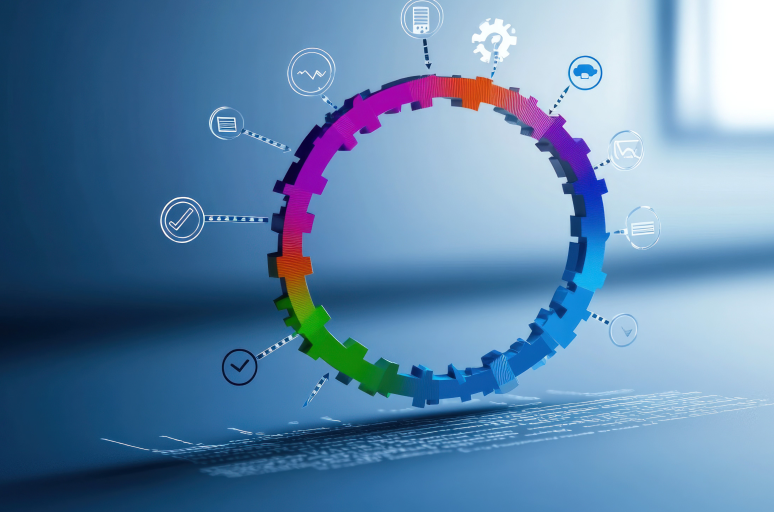Specialized modernization tools transform legacy systems into competitive assets while preserving core business logic and existing investments. Yet executives face a defining decision: which modernization solution will best put them back on the path to innovation?
Tools range from smart platforms that update decades-old code automatically to powerful migration tools that move data safely and smoothly. What we are seeing is that winning companies do not replace everything at once. Instead, they pick the right mix of tools to solve their specific challenges, turning technical debt into a competitive advantage step by step.
Application modernization tools fundamentals and business impact
The global application modernization services market is projected to grow from USD 19.82 billion in 2024 to USD 39.62 billion by 2029, at a CAGR of 14.9%. The game has changed completely in how companies approach system updates. The risky "rip and replace" approach is dead. Today's tools let companies fix specific problems without touching what already works.
They can modernize step by step, showing real value in months instead of years. This means lower risk, faster returns, and, last but not least, steady progress that everyone can see. In other words, companies use application modernization tools to analyze existing codebases, identify improvement opportunities, and automate much of the transformation process.
Converting, rewriting, or re-architecting existing applications allows them to align with current business requirements and technical standards. Luckily, technical debt elimination through structured modernization follows predictable patterns. First, assessment tools scan existing applications to identify dependencies, performance bottlenecks, and security vulnerabilities.
Next, transformation engines convert legacy code into contemporary languages and architectures. Finally, deployment platforms facilitate the transition to cloud-native environments. This systematic approach reduces project risks while ensuring business continuity throughout the modernization process. The question is, which tools to use?
Essential categories of application modernization tools and their functions
Today's modernization toolkit spans seven core categories, each solving specific transformation challenges. Leading organizations deploy multiple tool types in concert, crafting strategies that effectively manage risk and cost while delivering measurable business value.
Legacy code analysis and assessment platforms
Success in modernization starts with comprehensive visibility into existing applications. Modern analysis platforms scan source code across the enterprise, cataloging languages, frameworks, and dependencies with precision. CAST Software exemplifies this capability. Its platform processes applications across 35+ languages and quantifies technical debt in business terms that executives understand.
These tools map intricate system dependencies, revealing critical integration points that could fail during migration. By translating code complexity into dollar values, they enable data-driven prioritization.
Automated refactoring
Legacy application replatforming includes translating COBOL and PowerBuilder into modern programming languages such as C#, Java and Python. Transformation engines preserve valuable business logic and even restructure monolithic applications into microservices and serverless architectures. Recurring code structures are identified by advanced pattern recognition systems, and consistent transformations are applied across all the codebase. In many cases, the impact is substantial.
Real-world accelerators here include AWS Microservice Extractor for .NET that maps .NET monoliths and proposes service boundaries, and vFunction, observability-driven analysis to carve out services. These tools do not “magic-wand” the rewrite. Oppositely, they front-load the heavy discovery and generate scaffolding so teams can focus on business logic instead of plumbing.
Data transformation and migration toolsets
Modern data migration tools ensure integrity while transforming legacy structures into contemporary formats. These platforms manage complex schema conversions, data type mappings, and referential constraints with precision. They enable seamless data movement between systems, applying critical transformations along the way. Quality validation mechanisms ensure accuracy at every step. Among leading data modernization tools, AWS Database Migration Service (DMS) supports online migrations with minimal downtime, covering lift-and-shift, real-time replication, and transformation at scale.
Cloud-native development and deployment platforms
Containerization now defines best practice for enterprise application deployment. Docker and Kubernetes have become the foundation for modern infrastructure. And Gartner estimates that in the next two years, “more than 75% of all AI/ML deployments will use container technology as the underlying compute environment”.
The shift to cloud-native architectures represents more than technical evolution – it changes how organizations deliver value. Leading platforms enable teams to:
- scale automatically based on demand, eliminating over-provisioning and reducing costs,
- deploy applications faster through automated pipelines and infrastructure-as-code,
- maintain consistency across development, testing, and production environments,
- enable self-service capabilities for developers while maintaining security and governance,
- integrate with observability and monitoring tools.
API integrations
Successful modernization requires legacy systems to productively coexist with new architectures. Luckily, modernization software elegantly translates between protocols, turning SOAP services into REST endpoints and legacy batch processes into real-time streams. API gateways and integration platforms make this routine, letting teams preserve legacy backends while exposing modern contracts to new apps.
Low-code modernization software
The low-code approach extends beyond traditional application development platforms to include powerful automation and integration tools that modernize business applications without extensive coding. These platforms enable business users to create sophisticated workflows that previously required dedicated development resources. The most popular choices are:
- n8n – stands out as an open-source workflow automation platform that offers exceptional flexibility for technical teams. Unlike proprietary solutions, n8n can be self-hosted, providing complete data control, a critical feature for regulated industries handling sensitive information,
- Zapier – connects over 6,000 applications, where non-technical users can create complex multi-step workflows using pre-built templates and custom-built scenarios.
- Make – provides granular control over data flow, error handling, and conditional logic, with built-in features for data aggregation, iteration, and filtering that also place it between data modernization tools.
Top application modernization tools
Using structured modernization toolsets, ranging from performance monitoring to automated code refactoring, can support agility, reduce operational risk, and enable faster innovation. The following platforms represent leading solutions in their respective categories.
AWS SAM: Serverless and cloud-native framework for the builders
AWS Serverless Application Model targets professional development teams building cloud-native applications requiring elastic scalability and optimal performance or decomposing legacy monoliths into modern architectures. As one of the best legacy modernization tools, it provides infrastructure abstraction that ensures granular control, performance optimization, and cost-per-compute efficiency. The framework offers several advantages for modernization projects:
- simplified syntax – significantly reduces configuration blocks, lengthy declarations, and repetitive code patterns,
- local testing – enables developers to debug serverless functions on their own workstations,
- built-in best practices – automatically implements security and performance optimizations,
- integration support – connects easily with other AWS services and third-party tools.
These features accelerate serverless adoption while reducing common implementation errors. The AWS SAM is open-source and available at no charge. However, it needs to run in the cloud, following the standard cloud pay-for-what-you-use model for AWS.
However, SAM used as a legacy modernization software, also presents some limitations, e.g. the framework locks applications into AWS infrastructure, reducing portability. Also, learning curves remain steep for teams unfamiliar with serverless concepts.
Red Hat OpenShift: Enterprise-level container for the orchestrators
When companies start using containers and microservices to modernize their applications, they quickly discover it is far more complicated than expected. As long as Kubernetes has become the industry standard for orchestration, it is notoriously difficult to configure, secure, and manage in a production environment. In consequence, many organizations switch to Red Hat OpenShift instead.
Red Hat OpenShift helps with legacy application replatforming, managing, securing, and standardizing workloads in multi-cloud environments. As a hybrid cloud platform built on Kubernetes, its core value proposition is to provide a consistent and secure foundation for legacy system transformation. It is designed to build, deploy, and manage containerized applications at scale, regardless of where they run.
OpenShift accelerates modernization outcomes through:
- Developer productivity. For instance, integrated CI/CD pipelines automate build, test, and deployment processes.
- Multi-cloud flexibility. Applications run consistently across on-premises, public cloud, and edge environments. This prevents vendor lock-in while maximizing infrastructure investments.
- Operational automation. Self-healing capabilities and automated scaling reduce manual intervention requirements. It helps to significantly reduce operational overhead in IT teams.
- Security. Built-in security scanning, role-based access controls, and compliance frameworks protect modernized applications. Its HIPAA compliance is particularly valued by healthcare organizations.
These capabilities make OpenShift particularly suitable for large-scale modernization programs requiring enterprise governance and support. However, licensing costs exceed open-source Kubernetes alternatives. Resource requirements demand substantial infrastructure investments.
Microsoft PowerApps: Low-code for the assemblers
Microsoft PowerApps enables rapid application development through low-code interfaces constituting one of the most prominent application modernization trends. Low-code promises to democratize application creation, and within modernization contexts PowerApps accelerates the replacement of legacy applications while reducing development costs.
PowerApps as offers compelling advantages for modernization teams:
- rapid development – creates functional applications 10x faster than traditional coding,
- data connectivity – integrates with 300+ data sources including legacy databases,
- mobile-first design – automatically generates responsive interfaces for all devices,
- AI integration – incorporates artificial intelligence capabilities without coding,
- governance controls – maintains IT oversight while enabling citizen development.
These features particularly benefit organizations with large backlogs of legacy applications requiring modernization. Business units can address their specific needs without waiting for IT resources.
Platform limitations include performance constraints for complex applications. PowerApps struggles with sophisticated business logic requiring traditional programming. Data volume restrictions limit large-scale processing capabilities.
Microsoft ecosystem dependencies reduce flexibility for organizations using diverse technology stacks. Despite these limitations, PowerApps excels at rapidly modernizing departmental applications and workflow automations, making it one of the most popular app modernization tools.
Comparison of modernization platforms
The following table provides a comparative analysis across key application modernization tools to facilitate this important decision-making process.
This framework demonstrates that the choice of tool is a strategic one:
- to deliver an event-driven backend, an organization might adopt AWS SAM.
- to achieve standardized container deployments across hybrid and multi-cloud setups, an enterprise might deploy Red Hat OpenShift.
- to accelerate internal process digitization, a business unit might leverage Microsoft PowerApps.
A comprehensive modernization strategy will likely leverage tools from all three categories.
Transform your legacy systems with RST
Selecting the right modernization tool is just the beginning. Within legacy modernization trends, implementation is where theory meets reality. Real impact comes from combining the right tools, skilled execution, and a well-sequenced rollout plan. At RST, we provide complete modernization support. This minimizes risk, maintains business continuity, and ensures the organization can capture value quickly. The challenge lies in moving from concept to scale without losing momentum.
We help enterprises achieve exactly that. From evaluating your current systems and identifying the highest-impact modernization opportunities, to selecting, implementing, and scaling the right solutions. Our approach ensures you eliminate technical debt systematically while accelerating innovation cycles, delivering visible business value at every stage. Contact us today to discuss the best options.







